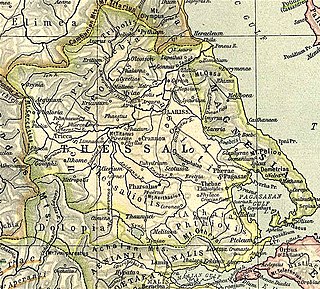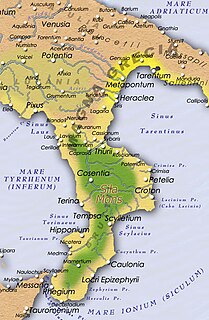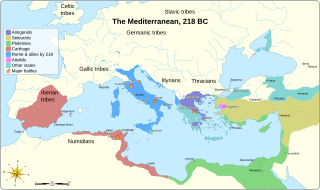Related Research Articles
This article concerns the period 219 BC – 210 BC.
Year 203 BC was a year of the pre-Julian Roman calendar. At the time it was known as the Year of the Consulship of Caepio and Geminus. The denomination 203 BC for this year has been used since the early medieval period, when the Anno Domini calendar era became the prevalent method in Europe for naming years.

Mago Barca was a Barcid Carthaginian who played an important role in the Second Punic War, leading forces of Carthage against the Roman Republic in Iberia and northern and central Italy. Mago was the third son of Hamilcar Barca, was the brother of Hannibal and Hasdrubal, and was the brother-in-law of Hasdrubal the Fair.

The Taurini were a Celto-Ligurian tribe dwelling in the upper valley of the river Po, around present-day Turin, during the Iron Age and the Roman period.

The Ligures were an ancient people after whom Liguria, a region of present-day north-western Italy, is named.

Demetrias was a Greek city in Magnesia in ancient Thessaly, situated at the head of the Pagasaean Gulf, near the modern city of Volos.

The battle or, more precisely, the battles of Croton in 204 and 203 BC were, as well as the raid in Cisalpine Gaul, the last larger scale engagements between the Romans and the Carthaginians in Italy during the Second Punic War. After Hannibal’s retreat to Bruttium due to the Metaurus debacle, the Romans continuously tried to block his forces from gaining access to the Ionian Sea and cut his eventual escape to Carthage by capturing Croton. The Carthaginian commander struggled to retain his hold on the last efficient port which had remained in his hands after years of fighting and was ultimately successful.
The Salyes or Salluvii were an ancient Celto-Ligurian people dwelling between the Durance river and the Greek colony of Massalia during the Iron Age. Although earlier writers called them 'Ligurian', Strabo used the denomination 'Celto-ligurian', and a Celtic influence is noticeable in their religion, which centred on the cult of the tête coupée. In fact, the Salyes were most likely at the head of a political and military confederation that united both Gallic and Ligurian tribes.

San Felice Circeo is a town and comune in the province of Latina, in the Lazio region of central Italy.

The Battle of Insubria in 203 BC was the culmination of a major war, carried out by the Carthaginian commander Mago, brother of Hannibal Barca, at the end of the Second Punic war between Rome and Carthage in what is now northwestern Italy. Mago had landed at Genoa, Liguria, two years before, in an effort to keep the Romans busy to the North and thus hamper indirectly their plans to invade Carthage's hinterland in Africa. He was quite successful in reigniting the unrest among various peoples against the Roman dominance. Rome was forced to concentrate large forces against him which finally resulted in a battle fought in the land of the Insubres (Lombardy). Mago suffered defeat and had to retreat. The strategy to divert the enemy's forces failed as the Roman general Publius Cornelius Scipio laid waste to Africa and wiped out the Carthaginian armies that were sent to destroy the invader. To counter Scipio, the Carthaginian government recalled Mago from Italy. However, the remnants of the Carthaginian forces in Cisalpine Gaul continued to harass the Romans for several years after the end of the war.
The Seduni were a Gallic tribe dwelling in the upper Rhône valley, around present-day Sion, during the Iron Age and the Roman period.
The Salassi or Salasses were a Gallic or Ligurian tribe dwelling in the upper valley of the Dora Baltea river, near present-day Aosta, during the Iron Age and the Roman period.

The Battle of Cartagena in 209 BC was a successful Roman assault on the Carthaginian stronghold New Carthage (Cartagena) in Iberia that took place in late January to early February of 209 BC.
The Tricastini were a small Gallic tribe dwelling in the modern Tricastin region, near present-day Saint-Paul-Trois-Châteaux, during the Iron Age and the Roman period.
This section of the timeline of Hispania concerns Spanish and Portuguese history events from the Carthaginian conquests to before the barbarian invasions.

Publius Cornelius Scipio Africanus was a Roman general and statesman, most notable as one of the main architects of Rome's victory against Carthage in the Second Punic War. Often regarded as one of the best military commanders and strategists of all time, his greatest military achievement was the defeat of Hannibal at the Battle of Zama in 202 BC. This victory in Africa earned him the epithet Africanus, literally meaning “the African,” but meant to be understood as a conqueror of Africa.

Mercenary life is recorded as a custom of Iron Age Spain, particularly in the central area of the Iberian peninsula. Departing from the native tribe and applying to serve in others was a way for economically disadvantaged youth to escape poverty and find an opportunity to use their fighting skills. Starting from 5th century BC, mercenary life would become a true social phenom in Hispania, with great numbers of fighters from distant lands coming to join the armies of Carthage, Rome, Sicily and even Greece, as well as other Hispanic peoples.
The Segovellauni were a small Gallic tribe dwelling in the modern Drôme department, near the present-day city of Valence, during the Iron Age and the Roman period.
The Intimilii or Intemelii were a Ligurian tribe dwelling on the Mediterranean coast, around present-day Ventimiglia, during the Iron Age and the Roman period.
The Ingauni were a Celto-Ligurian tribe dwelling on the Mediterranean coast, around the modern city of Albenga (Liguria), during the Iron Age and the Roman period.
References
- 1 2 Livy. Ab Urbe Condita Libri, 28:46.
- ↑ Pokorny, Julius (1959). "Zu den keltischen -nt- Suffixen". Münchener Studien zur Sprachwissenschaft. 15: 5–16.
- ↑ Talbert 2000, Map 16: Col. Forum Iulii-Albingaunum.
- ↑ Dyson 1985, p. 92.
- ↑ Dyson 1985, pp. 96–97.
Primary sources
- Livy (2019). History of Rome. Loeb Classical Library. Translated by Yardley, J. C. Harvard University Press. ISBN 978-0674992566.
Bibliography
- Dyson, Stephen L. (1985). The Creation of the Roman Frontier. Princeton University Press. ISBN 978-1-4008-5489-9.
- Talbert, Richard J. A. (2000). Barrington Atlas of the Greek and Roman World. Princeton University Press. ISBN 978-0691031699.